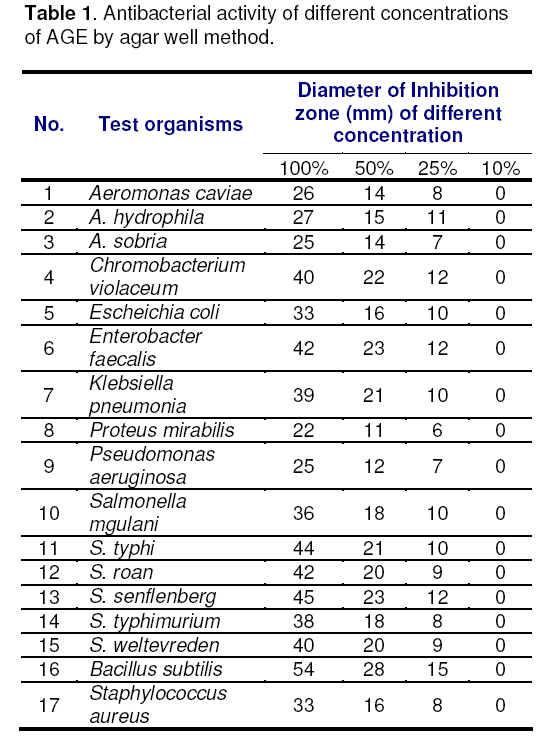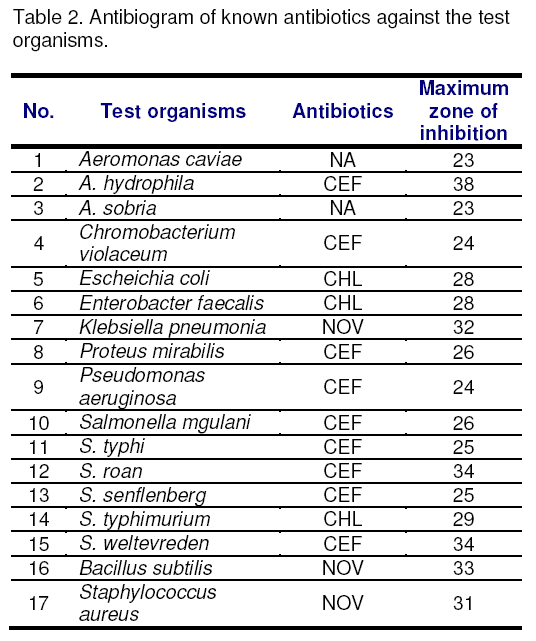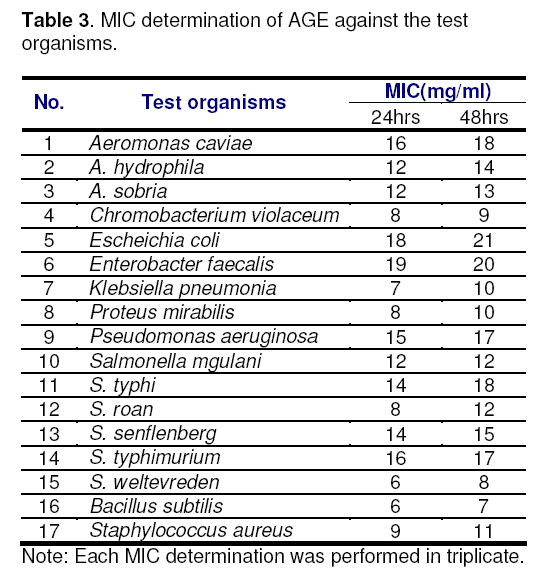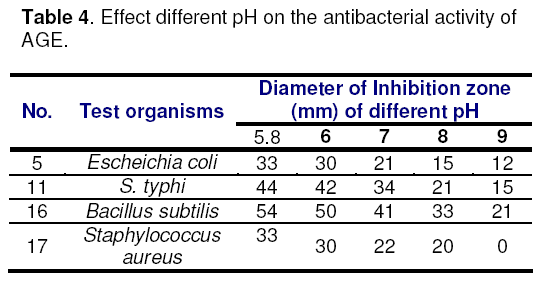In vitro Antibacterial Activity and Stability of Garlic Extract at Different pH and Temperature
Srinivasan Durairaj, Sangeetha Srinivasan, P. Lakshmanaperumalsamy
1Department of Biosystems and Agricultural Engineering,Michigan State University,East Lansing MI-48824,USA
2Department of Crop and Soil sciences,Michigan State University,East Lansing MI-48824,USA
3Department of Environmental Sciences,Bharathiar University,Coimbatore-614046,India
- Corresponding Author:
- Srinivasan Durairaj
Department of Biosystems and Agricultural Engineering
Michigan State University,East Lansing MI-48824,USA
Tel: +1-517-4328673
Fax: +1-517-432-2892
E-mail: sriniv36@msu.edu
Abstract
The antibacterial effects of aqueous garlic extract (AGE) against 17 multidrug-resistant gram-positive and gram-negative bacterial isolates, including Staphylococcus aureus, Salmonella typhi, Pseudomonas aeruginosa, Escherichia coli, and Proteus spp., were studied. Antibacterial activity of different concentrations of AGE by well-diffusion method was characterized by inhibition zones of 15 Gram-positives and two Gram-negative pathogenic bacteria. The maximum zone of inhibition was observed in Bacillus subtilis and the minimum was observed for Proteus sp. The minimum inhibitory concentration (MIC) was in the ranges of 6–11 mg/mL and 7–21 mg/mL, in Gram-positive and Gram-negative organisms respectively. The MIC values at 24 and 48 hours were not significant in the tested isolates. Further analysis revealed the antimicrobial efficacy of AGE is time and temperature dependent. Antibacterial efficacy of AGE maintained at room temperature was for maximum 7 days. At -20? temperature the activity was maintained for 90 days. In summary, the AGE showed a wide spectrum activity and appears to satisfy all of the criteria for antibacterial agents. These results suggest that garlic can be used to protect food and consumers from the risk of contamination from pathogenic microorganisms.
Keywords
Garlic,antibacterial activity,pH,temperature.
1. Introduction
Historically,garlic has been used for centuries worldwide by various societies to combat infectious disease. Garlic can be provided in the form of capsules and powders,as dietary supplements,and thus differ from conventional foods or food ingredients. Louis Pasteur was the first to describe the antibacterial effect of onion and garlic juices. Allium vegetables,particularly garlic (Allium sativum L.) exhibit a broad antibiotic activity against both Gram-positive and Gram-negative bacteria [1]. From the published research articles it is clear that the raw juice of garlic was effective against many common pathogenic bacteria [2],against the strains that have become resistant to antibiotics [3] and even toxin production by some pathogenic strains prevented by garlic [4].
There are extensive reports on the antibacterial activity of garlic juice,aqueous and alcoholic extracts,lyophilized powders,steam distilled oil and other commercial preparations of garlic. Harris et al. [5] published a mini review of the antimicrobial properties of garlic. The pharmacological effects of garlic have been reviewed by Singh and Singh [6]. In India,garlic has been used to prevent wound infection and food spoilage [7]. Han et al. [8] reported that the antibiotic activity of 1mg of allicin,is equated to that of 15 IU of penicillin. Recent reports also demonstrated the inhibitory activity of garlic aqueous extracts on numerous bacterial and fungal species [9-12].
Therapeutic effect of garlic is possible because of its oil- and water-soluble organosulfur compounds,which are responsible for the typical odor and flavor of garlic. Thiosulfinates play an important role in the antibiotic activity of garlic. Hughes and Lawson [13] showed that the antimicrobial activity of garlic is completely abolished when the thiosulfinates (e.g.,allicin) are removed from the extract. Also,upon reduction of allicin to diallyl disulfide,the antibacterial activity is greatly reduced [14]. Feldberg et al. [15] showed that allicin exhibits its antimicrobial activity mainly by immediate and total inhibition of RNA synthesis,although DNA and protein syntheses are also partially inhibited,suggesting that RNA is the primary target of allicin action. The structural differences of the bacterial strains may also play a role in the bacterial susceptibility to garlic constituents [16]. Due to the occurrence of unpleasant side effects and increasing resistance to the synthetic pharmaceuticals,there has been increasing interest in the quest for natural alternatives. Researchers are looking at plants that have been used as alternative therapies for generations. In this paper we evaluated the antimicrobial activity of crude extracts of garlic against seventeen bacterial pathogens and also an attempt has been made to study the effect of temperature and pH on the stability of the extracts against two Gram positive and two Gram negative pathogens.
2. Methods
Aqueous Garlic Extract (AGE) preparation
Fresh garlic (Allium Sativum L.) bulbs were purchased from a retail food store (Coimbatore,India). Then,the garlic bulbs were peeled,weighed (100 g),and cleaned garlic were taken and surface sterilized using ethanol. The ethanol was allowed to evaporate in a sterile laminar flow chamber,and the garlic was homogenized aseptically using a sterile mortar and pestle. The homogenized mixture was filtered through sterile cheesecloth. This extract was considered as the 100% concentration of the extract. The concentrations,75%,50%,25% and 10% were made by diluting the concentrated extract with appropriate volumes of sterile distilled water.
Microorganisms used
A total of 15 Gram negative and 2 Gram positive organisms were used in this study. The isolates Aeromonas caviae,A. hydrophila,A. sobria,Salmonella mgulani,S. typhi,S. roan,S. senflenberg,S. typhimurium and S. weltevreden were isolated from sea food. Chromobacterium violaceum,Enterobacter faecalis,Klebsiella pneumonia was obtained from Christian Medical College Hospital,Vellore. Escheichia coli,Proteus mirabilis,Pseudomonas aeruginosa,Bacillus subtilis and Staphylococcus aureus were obtained from the culture collection of Institute of Microbial Technology (IMTECH),Chandigarh,India.
Antibacterial activity testing using Agar well diffusion assay
The selected strains of bacteria were inoculated into 10 mL of sterile nutrient broth,and incubated at 37 ° C for 8 hours. The cultures were swabbed on the surface of sterile nutrient agar plates using a sterile cotton swab. Agar wells were prepared with the help of sterilized cork borer with 10 mm diameter [17]. Using a micropipette,100ul of different concentrations of garlic extracts (100%,75%,50%,25% and 10%) were added to the wells in the plate. The plates were incubated in an upright position at 37° C for 24 hours. The diameter of inhibition zones was measured in mm and the results were recorded. The inhibition zones with diameter less than 12 mm were considered as having no antibacterial activity.
Broth dilution method
The MIC of the AGE was determined by the broth dilution method. Briefly,each bacterium was grown to stationary phase in tryptic soy broth. Each cell suspension was adjusted spectrophotometrically to approximately 104 CFU/ml. Garlic extract concentration ranged from 50 to 2 mg/ml,and 25 ml of the bacterial cell suspension was added to the serially diluted garlic extract. Uninoculated tubes containing growth medium or growth medium and extract were used as controls. All incubations were at 37° C for 24 h and 48 hours. The MIC was defined as the lowest concentration of garlic extract that completely inhibits the growth of the organism.
Antibiotic sensitivity testing
The test microorganisms were also tested for their sensitivity against the antibiotics (30 mcg) (Table-2). The cultures were enriched in sterile nutrient broth for 6-8 hours at 37° C. Using sterile cotton swabs,the cultures were aseptically swabbed on the surface of sterile nutrient agar plates. Using an ethanol dipped and flamed forceps,the antibiotic discs were aseptically placed over the seeded agar plates sufficiently separated from each other to avoid overlapping of inhibition zones. The plates were incubated at 37 ° C for 24 hours and the diameter of the inhibition zones was measured in mm. All the media used in the present investigation were obtained from Hi-media Laboratories Ltd.,Mumbai,India.
Effect of temperature and pH on stability of AGE
Thermostability of AGE was determined by taking 10ml quantities in sterile capped tubes and kept in three different temperatures (room temperature 28+ 2° C,4° C and 20° C). The effect of pH on the stability of AGE at room temperature was tested by adjusting pH with 1N NaOH and/or 1N HCL (pH6,7,8 and 9) and allowed to stand for 3 hrs at room temperature. The activity of AGE was tested by agar-well diffusion assay as described above.
3. Results and Discussion
Determination of antimicrobial activity
From time immemorial man has been using various parts of the plants against common ailments with varying degree of success. The knowledge of drug has developed together with the evolution of scientific and social progress. Drugs derived from plants are effective,easily available,and less expensive and rarely have side effects. The practitioners of traditional and indigenous medicine rely mainly on medicinal plants and herbs for preparation of therapeutic substance. Initial screening for the potential antibacterial and antifungal compounds from plants may be performed by using the crude extracts. The two most commonly used methods to determine antimicrobial susceptibility are the dilution assay and the disc or agar well diffusion assay. Adaptations such as the agar overlay method may also be used. In some cases,the inoculated plates or tubes are exposed to UV light to screen for the presence of light-sensitizing photo chemicals. Here we used aqueous garlic extracts (AGE) in different concentrations by agar well diffusion assay. In the present investigation different concentrations of the aqueous garlic extracts (AGE) was tested for their inhibitory activity on 15 Gram-negative and 2 Grampositive bacteria (Table 1).

All test organisms were inhibited by AGE up to 25% concentration and the activity was a linear function of concentration. At 100%,the maximum zone of inhibition was observed against B. subtilis,a Grampositive organism and the minimum was against Proteus mirabilis,a Gram-negative organism. This indicates that AGE has the potential of a broad spectrum of activity against both Gram-positive and Gram-negative bacteria. But we can see the variation in the size of the inhibition zone among the different group of bacteria. This may be due to the lipid content of the membranes of the different groups of the microorganisms and the permeability of allicin and other garlic constituents. There are a greater number of studies showing antimicrobial activity of garlic against bacteria,fungi,virus and human intestinal protozoan parasites. Modern antimicrobial garlic research started with the classic studies of Cavalitto and Bailey [18]. De et al. [19] observed the antimicrobial activity in vitro against Bacillus subtilis,Escherichia coli and saccharomyces cerevisiae. Arora and Kaur [7] observed a significant bactericidal effect of garlic extract against Staphylococcus epidermidis,Salmonella typhi and various yeasts. Even bacteria resistant to antibiotic agents were sensitive to extracts of garlic [20]. The antibacterial activity of garlic is widely attributed to allicin. Allicin interferes with RNA production and lipid synthesis. If RNA cannot be produced,or produced in less amount then protein synthesis will be severely affected. It would be stopped at every stage due to the absence of messenger RNA,ribosomal RNA and transfer RNA. If amino acids and proteins cannot be produced then growth and development of the organism will not occur as they are essential for all parts of cell structure. Also,as lipid synthesis is affected,other parts of the cell are interfered with. The main effect being that the phospholipid biolayer of the cell wall cannot form correctly in both Gram positive and Gram negative bacteria. All these things contribute to the bacteria cannot grow in the presence of allicin or AGE. The diameter of the inhibition zone obtained against commonly used antibiotics is presented in Table 2.

The 100% AGE showed a higher inhibition zone,when compared to the activity with the commercially used antibiotics. Neomycin sulphate (250mg) is administered against S. aureus,E. coli and P. aeruginosa. Cephalexin (Cephalosporin) 250- 500mg is recommended for Proteus species and Ciprofloxacin 250-750mg is prescribed for K. pneumonia. AGE showed very good activity against these organisms. Antibiotics were used for therapy,but many of the pathogenic bacteria are resistant. Natural products of higher plants may offer a new source of antibacterial agents and from this result it is clear that the medicinal value of AGE is comparable to the present day antibiotics.
Minimum Inhibitory concentration
Table 3 shows the minimum inhibitory concentration (MIC) of AGE against the pathogenic organisms tested. The MIC of the extract varied from 7 to 21mg/ml for Gram negative bacteria and 6 to 11mg/ml for Gram positive bacteria. The Grampositive organism B. subtillis was more sensitive than other bacteria tested. MICs varied widely (6 to 21 mg/ml) between different species and mostly within a 2-fold AGE concentration range for different species of the genus Salmonella. MIC of AGE of our results is different from the values reported by Ross et al. [21] and Iwalokun et al. [22]. This may be due to the garlic preparations,different concentrations of the active compounds present in the extract and their interactions in the culture media. Also Ross et al.,[21] reported the MIC of garlic oil (GO) and garlic powder (GP) not the crude extract. Our results are in accordance with Banerjee and Sarkar [23],who also found aqueous extracts of garlic to possess potent bacteriostatic principle against many bacteria at varying concentrations. These included B. cereus (6–10 mg/ mL),S. aureus (30–40 mg/ mL) and E. coli (30 mg/ mL). Al-Delaimy and Ali (1970) reported that 4% (w/v) fresh garlic in extract inhibited the growth of Staph. aureus,E. coli,Salmonella typhi and Shigella dysenteriae.

Antibacterial activity of AGE at different temperature
Effect of AGE stores at three different temperatures was studied for 90 days (Figure 1).
Gupta and Viswanathan [24] reported that garlic extract stored at room temperature had less activity against B. cereus than the extract stored at -18° C. The stimulatory properties of dialyate of cooked garlic extract stored upto 24 hrs at 26 to 30 ° C towards certain bacterial and fungal pathogens was decreased [25]. Tynecka et al. [26] reported the antimicrobial activity of Allium ursinum juice decreases on storage above 4° C. Moore and Atkins [27] reported that the inhibitory property of garlic extract was unaffected by storage temperatures,but the fungicidal properties of the same garlic preparation decreased at different temperatures. It is a known fact that the loss of antibacterial activity of natural products by heating may be due to volatilization and/or the physical and chemical changes that take place during heating. Antibacterial activity of garlic extracts at 80° C to 90 ° C for 5 minutes completely destroyed [28,29]. In our study AGE stored at room temperature showed inhibitory activity against E. coli,S. typhi and B. subtilis upto 7 days. When AGE was stored at 4° C a moderate activity was observed against all the four tested pathogens 30days and 60 days if the same preparations are stored at -20° C.
Antibacterial activity of AGE at different pH
Stability of AGE at different pH levels was carried out at room temperature (Table 4). The pH value of the fresh AGE was 5.8. The maximum zone of inhibition against all the tested pathogens was observed at the original pH. A moderate level of activity was observed at the neutral pH and at pH 9 the activity was observed against E. coli (13 mm),S. typhi (15mm) and B. subtillis (21 mm). Our results are in accordance with Tynecka et al. [26] observed that the antimicrobial activity of Allium ursinum juice decreased on increase of the pH value.

4 Conclusions
From this study and the earlier reports it is clear that,garlic appears to satisfy all of the criteria for antibacterial agents,being cheap and safe. The historical view that garlic can 'cure all' may not be unjustified. Since the introduction of antibiotics there has been tremendous increase in the resistance of many bacterial pathogens. Scientists advance in their search for new bacterial targets to attack,bacteria evolve and as a result a large number of bacterial species have become resistant to antibacterial drugs. Hence,search for new antimicrobials is very important in recent times. Because garlic is known to act synergistically with antibiotics,and resistance has not been reported for garlic,more dose-response preclinical studies and eventually clinical studies should be done to assess the use of an antibiotic/garlic combination for bacteria that are difficult to eradicate. In view of the strong antibiotic properties and the complete absence of development of resistance further investigation upon the principles of the antimicrobial activity of juices from Allium species merits consideration.
Acknowledgements
We thank Head of the Department of Environmental Sciences,Bharathiar University,Coimbatore,India. We also thank Christian Medical College,Vellore,India for providing the bacterial cultures.
References
- Whitemore B.B.,Naidu A.S. (2000) Thiosulfinates. In: Naidu A.S. (Ed.),Natural food antimicrobial systems. Boca Raton,FL: CRC Press,pp. 265-380.
- Kumar A.,Sharma V.D. (1982) Inhibitory effect of garlic (Allium sativum Linn.) on enterotoxigenic Escherichia coli. Indian J Med Res.,76: 66-70.
- Jezowa L.,Rafinski T.,Wrocinski T. (1966) Investigations on the antibiotic activity of Allium sativum L. Herba Pol.,12:3-13.
- Dewitt J.C.,Notermans S.,Gorin N.,et al. (1979) Effect of garlic oil or onion oil on toxin production by Clostridium botulinum in meat slurry. J Food Prot.,42: 222-224.
- Harris J.C.,Cottrell S.L.,Plummer S.,et al. (2001) Antimicrobial properties of Allium sativum (garlic). Appl Microbiol Biotechnol.,57: 282-286.
- Singh V.K.,Singh D.K. (2008) Pharmacological Effects of Garlic (Allium sativum L.). Annu Rev Biomed Sci.,10: 6-26.
- Arora S.D.,Kaur J. (1999) Antimicrobial activity of spices. J Antimicrob Agents.,12: 257-262.
- Han J.,Lawson L.,Han G.,et al. (1995) A spectrophotometric method for quantitative determination of allicin and total garlic thiosulfinates. Annals of Biochemistry. 225: 157-160.
- Sivam G.P.,Lampe J.W.,Ulness B.,et al. (1997) Helicobacter pylori—in vitro susceptibility to garlic (Allium sativum) extract. Nutr. Cancer.,27: 118-121.
- Phay N.T.,Higashiyama M.,Tsuji,H.,et al. (1999) An antifungal compound from roots of welsh onion. Phytochemistry. 52: 271-274.
- Hsieh P.C.,Mau J.L.,Huang S.H. (2001) Antimicrobial effect of various combination of plant extracts. Food Microbiology. 18: 35-43.
- Ward P.M.,Fasitsas S.,Katz S.E. (2002) Inhibition,resistance development,and increased antibiotic and antimicrobial resistance caused by neutraceuticals. Journal of Food Protection. 65: 528-533.
- Hughes B.G.,Lawson D.L. (1991) Antimicrobial effects of Allium sativum L. (garlic),Allium ampeloprasum (elephant garlic),and Allium cepa (onion),garlic compounds and commercial garlic supplement products. Phytother Res.,5:154-158.
- Reuter H.D.,Koch P.,Lawson D.L. (1996) Therapeutic effects and applications of garlic and its preparations. In: Koch,H. P. & Lawson,D. L.,(Eds). Garlic: The Science and Therapeutic Applications of Allium sativum L. and Related Species,2nd ed. William & Wilkins,Baltimore,MD. pp. 135-212.
- Feldberg R.S.,Chang S.C.,Kotik A.N.,et al. (1988) In vitro mechanism of inhibition of bacterial growth by allicin. Antimicrob Agents Chemother.,32: 1763-1768.
- Tynecka Z.,Gos Z. (1975) The fungistatic activity of garlic (Allium sativum) in vitro. Ann Univ Mariae Curie-Sklodowska Sect D Med.,30: 5-13.
- Srinivasan D.,Sangeetha Nathan Suresh T.,Lakshmanaperumalsamy P. (2001) Antimicrobial activity of certain Indian medicinal plants used in folkloric medicine. J Ethnopharmaco.,l 74: 217-220.
- Cavallito C.J.,Bailey H.J. (1944) Allicin,the antibacterial principle of Allium sativum I. Isolation,physical properties and antibacterial action. J Am Chem Soc.,66: 1950-1951.
- De M.,Krishna De A.,Banerjee A.B. (1999) Antimicrobial screening of some Indian spices. Phytother Res. 13: 616-618.
- Indu M.N.,Hatha A.A.M.,Abirosh C.,et al.(2006). Antimicrobial activity of some of the south-indian spices against serotypes of escherichia coli,salmonella,listeria monocytogenes and aeromonas hydrophila. Brazilian J Micro.,37: 153-158.
- Ross Z.,O’Gara E.,Hill D.,et al. (2001) Antimicrobial properties of garlic oil against human enteric bacteria: evaluation of methodologies and comparisons with garlic oil sulphides and garlic powder. Appl Environ Microbiol.,67(1): 475-480.
- Iwalokun B.A.,Ogunledun A.,Ogbolu D.O.,et al. (2004) In vitro antimicrobial properties of aqueous garlic extract against multidrug-resistant bacteria and Candida species from Nigeria. Journal of Medicinal Food. 7(3): 327-333.
- Banerjee M.,Sarkar K.P. (2003) Inhibitory effect of garlic on bacterial pathogens from spices. World Journal of Microbiology and Biotechnology. 19: 565- 569.
- Gupta K.C.,Viswanathan R. (1953) Combined action of streptomycin and chloramphenicol with plant antibiotics against Tubercle bacilli. 1. Streptomycin and chloromphenicol with cepharanthene. II. Streptomycin and allicin. Antibiot Chemother.,5: 24- 27.
- Shashikanth,K.N.,Basappa S.,Sreenivasamurthy V. (1981) Studies on the antimicrobial and stimulatory factors of Garlic (Allium sativum Linn.). J Food Sci and Tech.,18: 44-47.
- Tyneca Z.,Syczesniak Z.,Gelowniak. (1993) The effect of various environmental conditions on the antimicrobial activity of Allium ursinum. Planta Med.,59: (Supplement Issue) A701.
- Moore G.S.,Atkins R.D. (1977) The fungicidal and fungistatic effects of an aqueous garlic extract on medically important yeast-like fungi. Mycologia. 69: 341-348.
- Dababneh B.F.A.,Al-Delaimy K.S. (1984) Inhibition of Staphylococcus aureus by garlic extract. Lebensm.-Wissenschaft und-Technol. 17: 29-31.

Open Access Journals
- Aquaculture & Veterinary Science
- Chemistry & Chemical Sciences
- Clinical Sciences
- Engineering
- General Science
- Genetics & Molecular Biology
- Health Care & Nursing
- Immunology & Microbiology
- Materials Science
- Mathematics & Physics
- Medical Sciences
- Neurology & Psychiatry
- Oncology & Cancer Science
- Pharmaceutical Sciences

